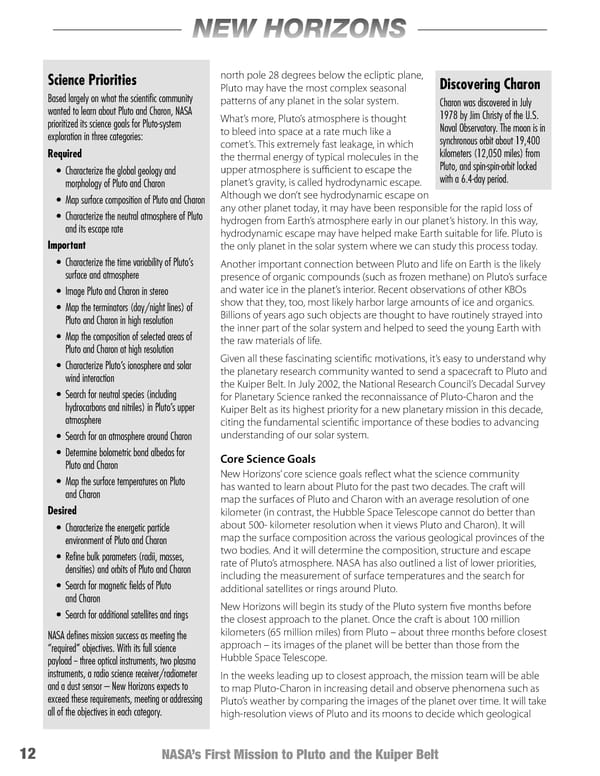NEW HORIZONS Science Priorities north pole 28 degrees below the ecliptic plane, Discovering Charon Pluto may have the most complex seasonal Based largely on what the scientific community patterns of any planet in the solar system. Charon was discovered in July wanted to learn about Pluto and Charon, NASA What’s more, Pluto’s atmosphere is thought 1978 by Jim Christy of the U.S. prioritized its science goals for Pluto-system to bleed into space at a rate much like a Naval Observatory. The moon is in exploration in three categories: comet’s. This extremely fast leakage, in which synchronous orbit about 19,400 Required the thermal energy of typical molecules in the kilometers (12,050 miles) from • Characterize the global geology and upper atmosphere is sufficient to escape the Pluto, and spin-spin-orbit locked morphology of Pluto and Charon planet’s gravity, is called hydrodynamic escape. with a 6.4-day period. • Map surface composition of Pluto and Charon Although we don’t see hydrodynamic escape on • Characterize the neutral atmosphere of Pluto any other planet today, it may have been responsible for the rapid loss of and its escape rate hydrogen from Earth’s atmosphere early in our planet’s history. In this way, hydrodynamic escape may have helped make Earth suitable for life. Pluto is Important the only planet in the solar system where we can study this process today. • Characterize the time variability of Pluto’s Another important connection between Pluto and life on Earth is the likely surface and atmosphere presence of organic compounds (such as frozen methane) on Pluto’s surface • Image Pluto and Charon in stereo and water ice in the planet’s interior. Recent observations of other KBOs • Map the terminators (day/night lines) of show that they, too, most likely harbor large amounts of ice and organics. Pluto and Charon in high resolution Billions of years ago such objects are thought to have routinely strayed into • Map the composition of selected areas of the inner part of the solar system and helped to seed the young Earth with Pluto and Charon at high resolution the raw materials of life. • Characterize Pluto’s ionosphere and solar Given all these fascinating scientific motivations, it’s easy to understand why wind interaction the planetary research community wanted to send a spacecraft to Pluto and the Kuiper Belt. In July 2002, the National Research Council’s Decadal Survey • Search for neutral species (including for Planetary Science ranked the reconnaissance of Pluto-Charon and the hydrocarbons and nitriles) in Pluto’s upper Kuiper Belt as its highest priority for a new planetary mission in this decade, atmosphere citing the fundamental scientific importance of these bodies to advancing • Search for an atmosphere around Charon understanding of our solar system. • Determine bolometric bond albedos for Core Science Goals Pluto and Charon New Horizons’ core science goals reflect what the science community • Map the surface temperatures on Pluto has wanted to learn about Pluto for the past two decades. The craft will and Charon map the surfaces of Pluto and Charon with an average resolution of one Desired kilometer (in contrast, the Hubble Space Telescope cannot do better than • Characterize the energetic particle about 500- kilometer resolution when it views Pluto and Charon). It will environment of Pluto and Charon map the surface composition across the various geological provinces of the • Refine bulk parameters (radii, masses, two bodies. And it will determine the composition, structure and escape densities) and orbits of Pluto and Charon rate of Pluto’s atmosphere. NASA has also outlined a list of lower priorities, including the measurement of surface temperatures and the search for • Search for magnetic fields of Pluto additional satellites or rings around Pluto. and Charon New Horizons will begin its study of the Pluto system five months before • Search for additional satellites and rings the closest approach to the planet. Once the craft is about 100 million NASA defines mission success as meeting the kilometers (65 million miles) from Pluto – about three months before closest “required” objectives. With its full science approach – its images of the planet will be better than those from the payload -- three optical instruments, two plasma Hubble Space Telescope. instruments, a radio science receiver/radiometer In the weeks leading up to closest approach, the mission team will be able and a dust sensor – New Horizons expects to to map Pluto-Charon in increasing detail and observe phenomena such as exceed these requirements, meeting or addressing Pluto’s weather by comparing the images of the planet over time. It will take all of the objectives in each category. high-resolution views of Pluto and its moons to decide which geological 12 NASA’s First Mission to Pluto and the Kuiper Belt
 New Horizons Page 18 Page 20
New Horizons Page 18 Page 20